By
Henry L. Herzfor
Cynthia Leitich Smith's
CynsationsLet's first distinguish between the terms "independent" and "small" publishers.
“Independent publishers” (IPs) are publishers that are not part of a larger corporation (e.g., the Big Five).
“Small publishers” are defined in the 2007 Writer's Market as those that average fewer than ten titles per year. So, while all small publishers are independent, not all independent publishers are small.
Pelican Publishing, home of my first three picture books (
Monster Goose Nursery Rhymes,
When You Give an Imp a Penny and
Little Red Cuttlefish), puts out about 60 titles a year. It's an independent publisher, but not a small publisher.
Having a book put out by a large publishing house, without question, offers some powerful advantages, including greater market reach, publishing industry relationships, more staff, and bigger budgets (and advances), than are often the case for smaller publishers. That said, there are significant benefits to working with independent publishers.
1. Access – Arguably the most important advantage of independent publishers is their relative ease of access. While most of the large publishers can only be queried via a literary agent, that restriction is rarely present with independent publishers. This makes independent publishers particularly appealing to newer writers who aren't represented by agents.
2. Relationships – independent publishers' smaller size tends to promote a closer relationship between the author and the independent publisher than may be possible with a large publisher. I feel comfortable contacting my editor and publicist at Pelican whenever it's necessary. This ease of interaction promotes a more pleasant working relationship.
3. Influence – By virtue, at least in part, of the closer relationship, authors may also have more influence with independent publishers than with large publishers. Independent publishers may be more likely to solicit and consider author feedback on cover design, artwork, font choice, etc. That said, trust your independent publisher to know its business.
4. Author's Efforts More Visible – This is the big fish in a small pond phenomenon. An individual author's promotional efforts and resulting sales are more visible and account for a larger percentage of sales at an independent publishers than at a large publisher.
5. More Flexible – Independent publishers, by their nature, and more flexible than large publishers. This can enable them to focus on niche or regional markets, and offer a home to a book that would not be considered by a large publisher. Independent publishers don't invest as much on a single book, and can thus more easily take calculated risks on innovative or unusual manuscripts.
6. Longer-Term Perspective – The philosophy of independent publishers is more aligned with a marathoner than with a sprinter. Slow and steady wins the race. Pelican keeps its books in print indefinitely.
7. Speed – Independent publishers can use their smaller size and greater flexibility to produce books faster than a large publisher. This was particularly true for my experience with Pelican, since I had complete artwork accompany my manuscripts (note: that is neither typical nor recommended for non-author-illustrators).
8. Stepping Stone – Independent publishers are quite capable of producing top notch books. A well-written and commercially successful book put out by an independent publisher may offer an effective stepping stone for authors' careers, including gaining access to literary agents and, with their help, larger opportunities.
Cynsational NotesHenry L. Herz's latest picture book is
When You Give an Imp a Penny (Pelican, 2016).
Before you lend an imp a penny, there’s something you should know—such a simple act of generosity could set off a side-splitting chain of events!
A colorful picture book full of mythology, mischief, and magic, When You Give an Imp a Penny shows us just what happens when an accident-prone—but well-intentioned—imp comes along asking for favors! The same writer/illustrator duo that brought you Monster Goose Nursery Rhymes brings to life a comedy of fabled proportions.Find
Henry at
Facebook and
@Nimpentoad at Twitter.
by Henry Herz
Everything I know about writing picture books, I learned from animals.
Animals make great picture book characters. Just ask the Very Hungry Caterpillar. And animals offer authors and illustrators nine B’s of inspiration for creating PBs:
Be a sponge.
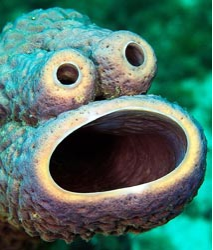
Soak up everything around you. View, listen, sniff, taste, and feel. Watch people (in public, not with a telescope from your house), read books (especially picture books), and watch TV and movies. Take notes. Even the most mundane situations can unexpectedly feed your muse.
Be a sharktopus.
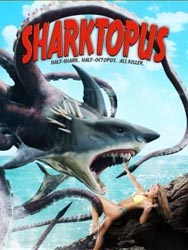
OK, that’s not a real animal, but I’m making a point here, people. Combine elements into unlikely (and therefore hilarious) pairs, as in Doreen Cronin’s Click Clack Moo: Cows That Type. Practice riffing on the things you soak up. I did a classroom reading where this boy had a torn-up sneaker. I thought, picture book title: The Boy With Exploding Sneakers. Let your creativity run free.
Be a honey badger.
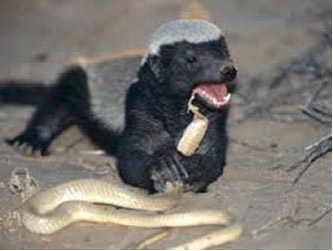
Have no fear. Don’t be scared to put words to paper. Don’t flee from constructive criticism. Don’t be afraid of rejection. They all line the path to traditional publication. Honey badger don’t care, and neither should you! Get outside your comfort zone.
Be a dung beetle.

Be tenacious, even on crappy days. Becoming published isn’t easy. But it won’t happen if you stop trying. The journey of a thousand miles begins with a one step. Revise, revise, revise. But remember that perfect can be the enemy of good enough. At some point, you need to submit!
Be an armadillo.

You need to be thick-skinned and learn to roll with the punches. Understand that a publisher’s or agent’s rejection isn’t personal, but it is highly subjective. Many great works of literature were rejected repeatedly before being published, so you’re in good company.
Be an ant.
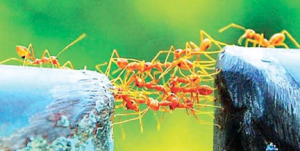
No man is an island, and no ant is a bridge. Teamwork is your best friend. Take advantage of critique groups to hone your craft. Join the Society of Children’s Book Writers and Illustrators (SCBWI) to develop a support network. Leverage social media to connect with fellow writers. You’re not alone.
Be a hagfish.
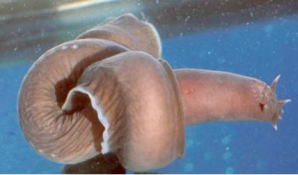
Be flexible enough to incorporate helpful feedback. But feel free to ignore feedback that doesn’t resonate with your gut. Follow the rules, but recognize that they can be broken when the result is a success. Drew Daywalt’s The Day the Crayons Quit is a picture book with over 1,000 words and inanimate characters. But it’s also a New York Times bestseller.
Be a peacock spider.
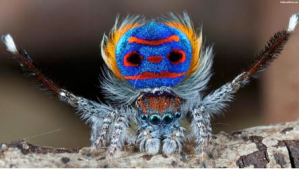
Male peacock spiders don’t just have stunning colors. They have a delightfully entertaining mating dance (think MC Hammer’s “Can’t Touch This”). They show the ladies some enthusiasm! They wear their passion on their, er, sleeves. Writing is also an act of passion. Write about what you love. Have fun writing. Write the story that is inside you, trying to get out. But hopefully not like a chestburster from Alien, or Ian Ziering in the final scene of Sharknado.
Be a cat.

Cats are lucky. They always land on their feet, and have nine lives.
There’s an expression, “luck favors the prepared.” Working at the other eight B’s is the best way to earn some luck. Good luck to you!

 Henry Herz has masters degrees in engineering and political science, neither of which help him write children’s books. He enjoys moderating sci-fi/fantasy literature panels at conventions, eating Boston Creme Pie, and writing children’s books with his sons Josh and Harrison. Their indie-published Nimpentoad was featured in Young Entrepreneur, Wired GeekDad, and CNN. Their picture book, Monster Goose Nursery Rhymes, will be published by Pelican in January 2015. Henry edited the YA dark fantasy anthology, Beyond the Pale, with stories from Peter S. Beagle, Heather Brewer, Jim Butcher, Rachel Caine, Kami Garcia, Nancy Holder, Jane Yolen and others. He interviews KidLit authors and illustrators at www.henryherz.com.
Henry Herz has masters degrees in engineering and political science, neither of which help him write children’s books. He enjoys moderating sci-fi/fantasy literature panels at conventions, eating Boston Creme Pie, and writing children’s books with his sons Josh and Harrison. Their indie-published Nimpentoad was featured in Young Entrepreneur, Wired GeekDad, and CNN. Their picture book, Monster Goose Nursery Rhymes, will be published by Pelican in January 2015. Henry edited the YA dark fantasy anthology, Beyond the Pale, with stories from Peter S. Beagle, Heather Brewer, Jim Butcher, Rachel Caine, Kami Garcia, Nancy Holder, Jane Yolen and others. He interviews KidLit authors and illustrators at www.henryherz.com.
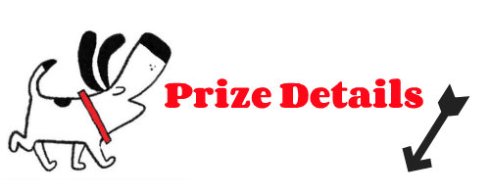
Henry is offering two picture book critiques to two PiBoIdMo winners!
These prizes will be given away at the conclusion of PiBoIdMo. You are eligible for these prizes if:
- You have registered for PiBoIdMo.
- You have commented ONCE ONLY on today’s post.
- You have completed the PiBoIdMo challenge. (You will have to sign the PiBoIdMo Pledge at the end of the event.)
Good luck, everyone!






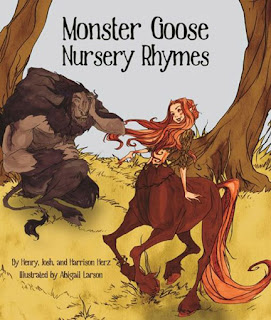











 Henry Herz has masters degrees in engineering and political science, neither of which help him write children’s books. He enjoys moderating sci-fi/fantasy literature panels at conventions, eating Boston Creme Pie, and writing children’s books with his sons Josh and Harrison. Their indie-published Nimpentoad was featured in Young Entrepreneur, Wired GeekDad, and CNN. Their picture book, Monster Goose Nursery Rhymes, will be published by Pelican in January 2015. Henry edited the YA dark fantasy anthology, Beyond the Pale, with stories from Peter S. Beagle, Heather Brewer, Jim Butcher, Rachel Caine, Kami Garcia, Nancy Holder, Jane Yolen and others. He interviews KidLit authors and illustrators at
Henry Herz has masters degrees in engineering and political science, neither of which help him write children’s books. He enjoys moderating sci-fi/fantasy literature panels at conventions, eating Boston Creme Pie, and writing children’s books with his sons Josh and Harrison. Their indie-published Nimpentoad was featured in Young Entrepreneur, Wired GeekDad, and CNN. Their picture book, Monster Goose Nursery Rhymes, will be published by Pelican in January 2015. Henry edited the YA dark fantasy anthology, Beyond the Pale, with stories from Peter S. Beagle, Heather Brewer, Jim Butcher, Rachel Caine, Kami Garcia, Nancy Holder, Jane Yolen and others. He interviews KidLit authors and illustrators at 
Who isn’t fascinated by animals. They are perfect characters for children. Thanks for a great post and reminder to look around our everyday world for inspiration.
Thank you for this great post, one of the things that has really helped my writing is being part of a picture book critique group. It’s great to work with support from other writers. Thank you also for introducing me to a peacock spider – I’ve never seen one before!
Lisa Connors
Love this post! I love anything about animals and these metaphors will keep me motivated. Thanks!
We can learn so much from nature. And what unusual creatures you’ve introduced us to! Thank you for reminding me of that, Henry!
Thanks for the great post. I love the reminder to combine animals and unlikely pairs to see where it takes you.
Loved the B’s. Looking back over them, I think #9 sticks out for me. I’ve been saying I feel good about my writing and I believe in it. Now, I’ll add, and I feel lucky! Thanks for a different outlook on the writing journey.
There is such a slight degree of separation between our lives and the other creatures we share our world with. Thank you, Henry for your enjoyable post this morning.
Thanks, Henry for a post I plan to copy and reread often. As both an animal lover and PB author, your B’s connected Big-time!.
Great and fun post! Great advice to follow.
Thank you for introducing me to some amazingly bizarre and inspiring creatures!
I love this post! It’s so funny, but so true. I’ll remember that photo of the armadillo when I need to be thick-skinned and roll with the punches.
Thank you for the ideas on how to keep engaged in the world around us, and keep our eyes open for all of the story possibilities. :)
My new goal in life: be a sharktopus. Thanks for your post!
What fun! What vivid advice! Thank you!
This was incredibly entertaining and helpful. Thank you!
I loved the pictures and suggestions. Thanks for the great post
Fun post with some of my favorite animals! :)
Thank you for a cheerfuly inspiring post.
Animals make everything so much more fun!